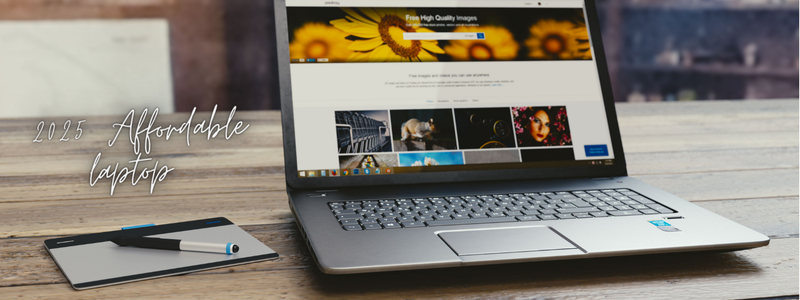Table of Contents

In 2025 affordable laptop for seniors , technology continues to evolve rapidly, but one key demographic often underserved or overwhelmed by these advancements is the senior population. As digital inclusion becomes increasingly vital for everything from healthcare access to maintaining social connections, finding an affordable, senior-friendly laptop has never been more important. Seniors today are not only browsing the internet or using email—they’re video calling family, managing online banking, reading digital books, streaming media, and even attending virtual healthcare appointments. Therefore, a laptop for seniors must balance affordability with usability, simplicity with reliability, and accessibility with performance. The ideal affordable laptop in 2025 caters to the unique needs of older users, including those with limited technical knowledge, mobility issues, or vision and hearing impairments. To be effective, these devices must offer clear, readable displays (preferably 14 inches or larger), easy-to-use keyboards, responsive trackpads or touchscreens, and long battery life. Affordability in 2025 usually means a price point under $500, though stretching to $600 can open up more powerful and accessible models with features that benefit older adults. Chromebooks remain a top contender in this space due to their low cost, simplicity, and integration with Google services that are both reliable and widely used. A model like the Lenovo IdeaPad Flex 3 Chromebook offers a lightweight 2-in-1 design, a touchscreen, and all-day battery life, making it ideal for casual users. It runs ChromeOS, which boots quickly, is resistant to viruses, and receives automatic updates, reducing the maintenance and troubleshooting that can frustrate some seniors. Similarly, the HP Chromebook 14 is another well-regarded choice—it boasts a large, bright display and a full keyboard, ensuring comfort for users with vision limitations or arthritic hands. For seniors who want a more traditional Windows environment—perhaps because they are accustomed to it or require compatibility with specific software—devices like the Acer Aspire 3 or the ASUS VivoBook 15 strike a good balance between cost and performance. These laptops often come with AMD Ryzen or Intel i3 processors, 8GB of RAM, and SSD storage—all of which ensure smooth performance for web browsing, video streaming, and basic productivity tasks. Windows 11, which powers these machines, now offers several accessibility features such as voice typing, magnifier, and live captions that make it friendlier to the aging population. Microsoft has also worked to make its user interface more intuitive and clean, with larger touch targets and simplified layouts that benefit senior users. For those with vision problems, laptops with high-resolution displays (1080p or higher) and anti-glare screens are helpful, especially if they can be adjusted for contrast and font size easily. In 2025, accessibility settings on both ChromeOS and Windows OS allow for font scaling, screen readers, and color inversion, which means seniors with low vision can tailor their devices to their specific needs. Touchscreen laptops are particularly helpful, as they remove the complexity of using a trackpad or mouse—an interface that can be difficult for those with hand tremors or reduced fine motor skills. Models such as the Dell Inspiron 14 2-in-1 or Lenovo IdeaPad Duet 5 Chromebook combine these usability features in a portable, affordable package. Additionally, audio quality matters—a laptop with clear, loud speakers or the ability to easily pair with Bluetooth hearing aids or wireless headphones is a major plus. The built-in microphones and webcams should be of decent quality, especially given the rise in telehealth and video calling platforms like Zoom, Google Meet, and Microsoft Teams. Many newer models now include dual-array microphones and AI noise cancellation to ensure voices are heard clearly. For seniors who are new to computing or need a simplified environment, companies like ASUS and Acer have started shipping laptops with custom software environments or simplified launchers, making it easier for users to access common tasks like checking email, browsing the web, or launching video calls without navigating through complex menus. Some third-party services, such as “Simple Senior” software or “Eldy,” offer add-on user interfaces that overlay the operating system with large buttons and clear navigation, optimizing the laptop experience for elderly users. When considering affordability, it’s also important to look beyond just the sticker price. Battery life, durability, and warranty support can significantly impact the long-term cost of ownership. A laptop that runs for 10-12 hours on a charge reduces dependency on power outlets—ideal for seniors who may not want to fuss with cords frequently. Lightweight designs—preferably under 3.5 pounds—help users who may have mobility limitations or arthritis. Many affordable models now include solid-state drives (SSDs) instead of traditional hard drives, leading to faster boot times, improved reliability, and lower power consumption. Brands like Acer, HP, and Lenovo have all leaned into this trend in 2025, and it has dramatically improved the user experience for budget-conscious consumers. Another essential factor is tech support. Many seniors prefer live assistance or in-person help, so laptops that come with robust customer service options or are supported by local retailers (like Best Buy’s Geek Squad or Micro Center’s in-house teams) may be more attractive. Some retailers now also bundle setup services or include guided tutorials for first-time users. For seniors without tech-savvy family members, having access to phone support or in-home setup can make the difference between a laptop that sits unused and one that becomes a daily companion. Many communities also offer free computer literacy classes or one-on-one tech help sessions through public libraries or senior centers—making it worthwhile to choose devices that are commonly supported in these environments. On the software side, lightweight and familiar apps are preferred. Google Chrome remains the go-to browser for simplicity and speed. Email apps like Gmail or Outlook with large font settings and integrated calendars make daily tasks more manageable. Voice assistants such as Google Assistant and Microsoft’s Copilot (previously Cortana) can help with reminders, weather forecasts, and setting appointments using voice commands—something especially useful for users who have difficulty typing. Antivirus and system maintenance should be minimal—another reason why Chromebooks are popular, as they handle updates and security automatically. For Windows laptops, tools like Windows Security or lightweight antivirus software like Bitdefender Free Edition are often sufficient. For those interested in entertainment, streaming apps like Netflix, Spotify, and YouTube are all easily accessible and optimized for most entry-level laptops. Many senior users also enjoy digital photo management, and services like Google Photos or Microsoft Photos offer intuitive platforms for viewing and organizing family pictures. Importantly, affordability doesn’t mean cutting corners in 2025—it means value, reliability, and design choices tailored to the user. The right laptop can significantly improve the quality of life for seniors by reducing isolation, enabling independence, and opening up a world of learning and entertainment. As more public services, social activities, and healthcare access shift online, bridging the digital divide becomes a moral and practical imperative. Manufacturers are slowly catching up to this idea, producing laptops that don’t just fit a budget, but meet the lifestyle and needs of older adults. Government programs in some countries, including the U.S., Canada, and parts of Europe, now offer subsidized devices or digital literacy training to encourage adoption among the elderly—a promising trend that may become more widespread by the end of the decade. Ultimately, an affordable laptop for seniors in 2025 is more than just a machine; it’s a gateway to staying connected, informed, entertained, and empowered. The best device is one that fits comfortably into a senior’s daily life—easy to learn, pleasant to use, and reliable in its function. Whether it’s a $250 Chromebook, a $450 Windows laptop, or a convertible 2-in-1 for $600, there’s something out there that can enrich the lives of older users without overwhelming them or draining their savings. And as awareness grows among manufacturers, tech educators, and families, the market is finally recognizing that the golden years deserve golden tech—accessible, affordable, and affirming.

Affordable Laptops for Seniors in 2025
As technology becomes more important in daily life, especially for staying connected, managing healthcare, and accessing services, seniors increasingly need user-friendly and affordable laptops. In 2025, there are many great options under $600 that provide the right balance of simplicity, performance, and value.
What Seniors Need in a Laptop
2025 Affordable laptop for seniors When choosing a laptop for a senior, it’s important to prioritize:
- Ease of Use: A clean interface, simple operating system, and intuitive controls are essential.
- Readable Display: At least a 14-inch screen with Full HD (1080p) resolution is best for readability.
- Keyboard Comfort: A full-size keyboard with large keys is better for those with arthritis or low vision.
- Battery Life: A long-lasting battery (8+ hours) means less hassle with charging.
- Weight: Lightweight models (under 4 pounds) are easier to carry.
- Accessibility Features: Voice control, screen magnification, and high contrast modes help those with hearing or vision difficulties.
Top Affordable Laptop Options for Seniors (2025)
🟢 1. Lenovo IdeaPad Flex 3 Chromebook
- Price: Around $300
- Why it’s good: Lightweight 2-in-1 with a touchscreen; runs ChromeOS which is simple and secure; great for browsing, video calls, and emails.
- Pros: Fast startup, long battery life (10+ hours), very easy to use.
- Cons: Limited for offline work and advanced software.
🟢 2. HP Chromebook 14
- Price: Around $280–$320
- Why it’s good: 14-inch screen with excellent readability and a comfortable keyboard.
- Pros: Simple ChromeOS, affordable, great screen size.
- Cons: Best suited for internet-based tasks.
🟢 3. ASUS VivoBook 15 (Windows 11)
- Price: Around $400–$500
- Why it’s good: Offers a full Windows experience for seniors more comfortable with traditional computers.
- Pros: Large screen, fast SSD storage, good performance for everyday use.
- Cons: Slightly heavier and more complex than a Chromebook.
🟢 4. Acer Aspire 3
- Price: Around $450
- Why it’s good: One of the most budget-friendly Windows laptops with a Ryzen 3 processor and SSD.
- Pros: Great for multitasking and web use, familiar Windows experience.
- Cons: Not ideal for gaming or photo editing.
🟢 5. Lenovo IdeaPad Duet 5 Chromebook (2-in-1)
- Price: Around $400
- Why it’s good: Combines tablet convenience with a detachable keyboard; bright OLED touchscreen is easy on the eyes.
- Pros: Portable, very clear display, excellent for video calls and light browsing.
- Cons: May feel too tablet-like for seniors who prefer a traditional laptop.
Why Chromebooks Are a Great Choice
Chromebooks are often the best value for seniors because they:
- Are virus-resistant and auto-update
- Have a simple, clean interface
- Work great for everyday tasks like email, video calls, and watching shows
- Are typically cheaper than Windows laptops
Windows Laptops: Better for More Features
If the senior user is already comfortable with Windows or needs specific apps (like Microsoft Office or Zoom desktop), an affordable Windows laptop is better. Choose models with:
- At least 8GB RAM
- SSD storage (256GB is enough for most)
- Windows 11 Home (or S mode for added security)
Helpful Features for Seniors
Look for:
- Touchscreen for easier navigation
- Backlit keyboard for better visibility
- Voice assistants like Google Assistant or Microsoft Copilot
- HD Webcam & Speakers for clear video calls
Tips When Buying
- Buy from retailers with good return policies and tech support (e.g., Best Buy, Costco, Amazon).
- Consider extended warranties or in-home setup help.
- Check for discounts—some stores offer senior or seasonal deals.
Conclusion
In 2025, seniors don’t need to spend a fortune to get a capable, easy-to-use laptop. Whether it’s a simple Chromebook for staying connected or a lightweight Windows laptop for more flexibility, there are plenty of affordable options under $500. The best laptops for seniors focus on comfort, clarity, and simplicity—so that technology empowers rather than frustrates. With the right laptop, seniors can enjoy entertainment, communication, and learning right at their fingertips.
